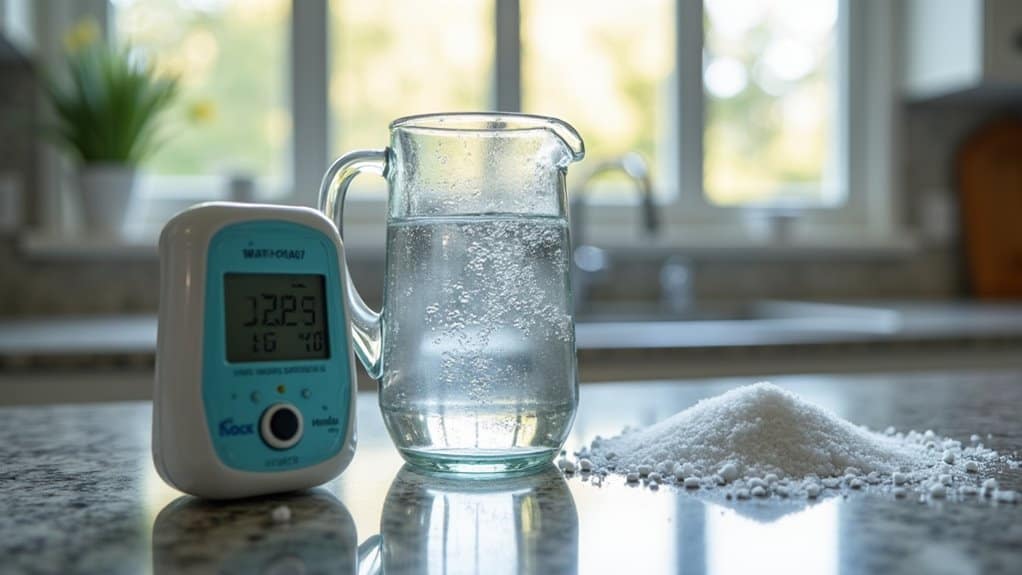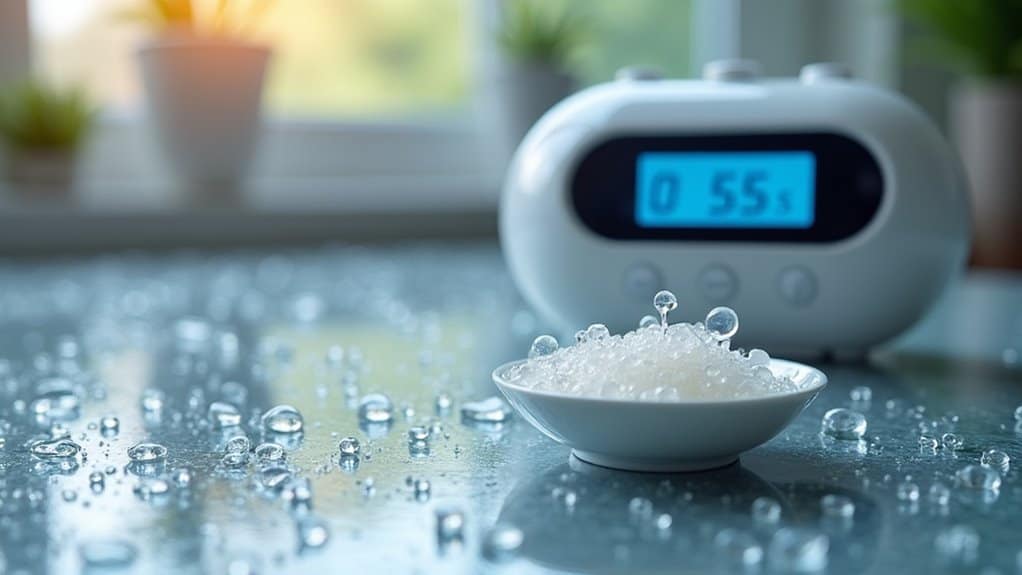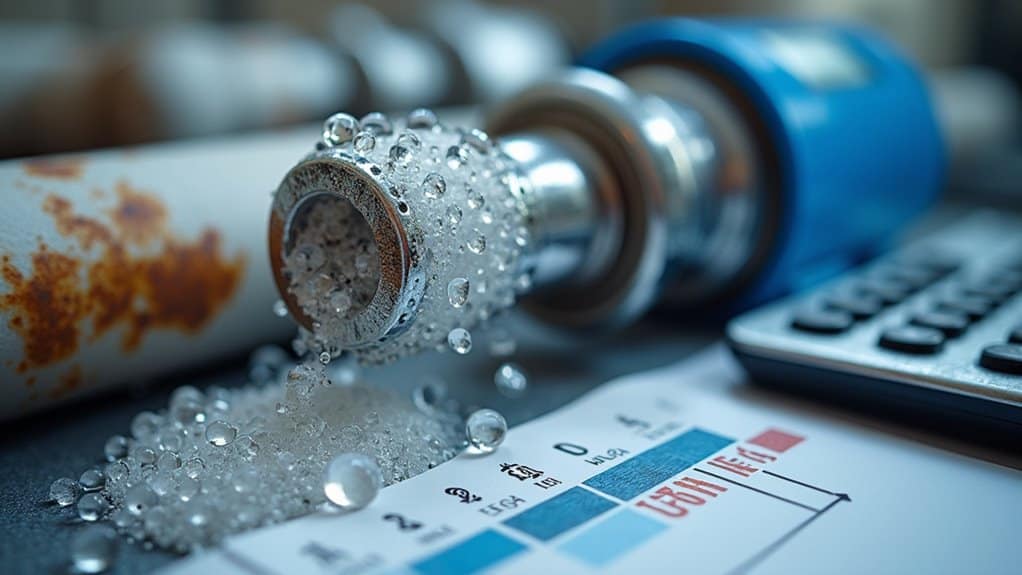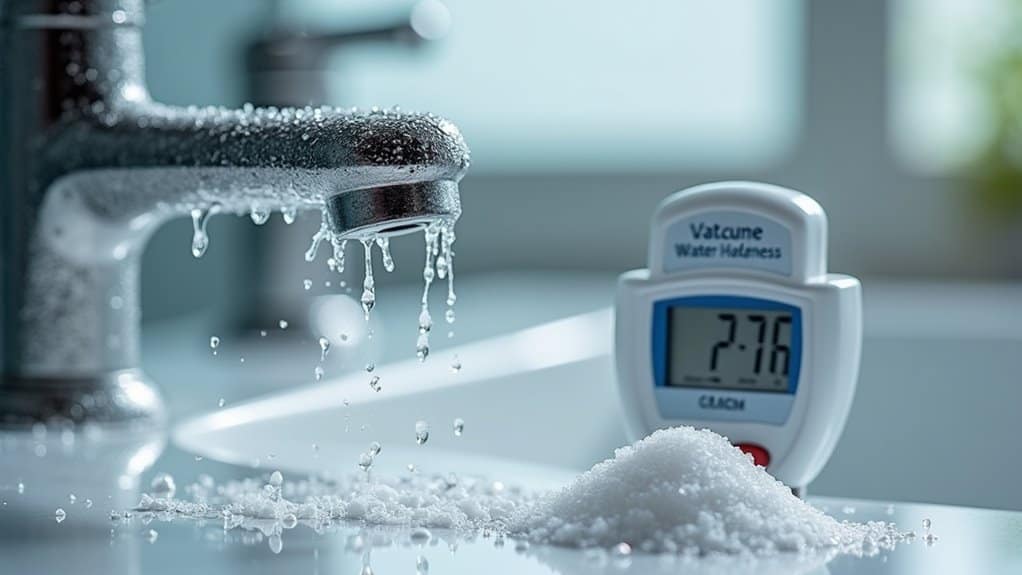Your water hardness level (GPG) directly determines the grain capacity your water softener needs. We calculate this by multiplying your daily water usage (gallons) by your hardness level. For example, a family of four using 300 gallons at 10 GPG requires a system capable of processing 3,000 grains daily. Iron content adds 4-5 GPG per 1 ppm to your calculations. Proper sizing ensures optimal performance and prevents wasteful regeneration cycles.
Key Takeaways
- Daily grain removal requirement equals your water usage in gallons multiplied by water hardness in GPG.
- A hardness level of 7-10.5 GPG requires a larger capacity softener to prevent scaling and appliance damage.
- For every 1 ppm of iron in your water, add 4-5 GPG to your hardness number when calculating softener size.
- A family of four typically needs a system that processes at least 3,000 grains daily for optimal performance.
- Properly sized water softeners should regenerate every 1-3 days for maximum efficiency and salt conservation.
What Your GPG Number Means for Your Household

When you understand your home’s GPG (grains per gallon) number, you gain critical insight into your water quality and its impact on your daily life.
This measurement reveals calcium carbonate concentration, with each grain representing about 17.1 ppm.
At 0-3.5 GPG, your water is soft with minimal issues.
From 3.5-7 GPG, expect spotty dishes and dry skin.
Hard water (7-10.5 GPG) causes crusty faucets and reduces appliance efficiency by up to 33% annually, potentially leading to appliance damage if left untreated.
Very hard (10.5-14 GPG) or extreme water (14+ GPG) demands immediate treatment to prevent severe scaling and premature appliance failure. These classifications help determine the appropriate water treatment needs for your household.
Calculate Your Daily and Weekly Grain Removal Requirements

Determining your water softener’s proper size requires accurate calculation of your household’s daily and weekly grain removal needs. To calculate daily requirements, multiply your water usage (gallons) by water hardness (gpg). For a family of four consuming 300 gallons daily with 10 gpg hardness, you’ll need 3,000 grains daily. Additionally, it’s essential to account for peak demand periods when calculating your softener size.
Don’t forget to add 4 gpg for each 1 ppm of iron. Weekly requirements follow a similar formula: daily grains × 7 days. A 20,000-grain system handling 3,000 grains daily will regenerate approximately every 6-7 days. Consider peak demands, seasonal variances, and household size when finalizing your calculations. Households with simultaneous fixture usage during mornings or evenings typically require larger capacity softeners to maintain consistent water quality.
Matching Your Water Hardness to the Right Softener Capacity

Water hardness levels directly determine the appropriate softener capacity for your home’s water treatment system.
We measure hardness in grains per gallon (GPG), with ranges from soft (0-3 GPG) to very hard (16+ GPG). Your softener’s grain capacity must handle your household’s daily water consumption multiplied by your hardness level. A well-sized softener contributes to optimal performance, ensuring you get the best results from your system.
- Undersized systems regenerate too frequently, wasting salt and water.
- Oversized units cost more without providing proportional benefits.
- Proper sizing ensures optimal water quality with minimum maintenance.
- Regional variations may require adjustments beyond standard calculations.
A family of four typically requires a system that can process at least 3,000 grains daily based on average consumption patterns.
For accurate sizing, convert mg/L to GPG by dividing by 17.1, then calculate your daily grain removal needs.
How Iron Content and Usage Patterns Affect Your Sizing Decision

Beyond basic hardness levels, iron content and household usage patterns significantly impact your water softener sizing calculations. To maximize efficiency, it is essential to understand water softener capacity so that your system can handle the specific demands of your household. For every 1 ppm of iron, we recommend adding 5 gpg to your hardness number, as iron reduces resin efficiency by nearly 30%. This adjustment prevents staining and protects your equipment investment.
Your household size demands specific capacity: 1-2 people need 30 gallons daily, 3-4 people require 60 gallons, while 5+ residents need 80+ gallons. Appliances like dishwashers increase demand by 10-20%. Maintain minimum flow rates of 7-10 gpm to prevent pressure drops during simultaneous use. Achieving regeneration every 1-3 days ensures optimal efficiency and extends the lifespan of your water softener system.
Frequently Asked Questions
How Long Do Water Softening Resin Beds Typically Last?
We find water softener resin beds typically last 10-15 years in residential settings under optimal conditions, though lifespan varies with water hardness, contaminants, maintenance practices, and resin quality.
Can I Install a Water Softener Myself or Need Professional Help?
While DIY installation is possible with basic plumbing skills, we recommend professional help if you’re inexperienced with pipe cutting, soldering copper pipes, or creating proper drain setups with air-gap fittings.
How Much Salt Will My Water Softener Use Monthly?
We estimate your softener will use 25-75 pounds monthly, depending on water hardness (10-15 GPG), household size, system efficiency, and salt purity. New demand-based models use 20-30% less salt.
Are There Salt-Free Alternatives to Traditional Grain-Based Water Softeners?
Yes, we offer salt-free alternatives like Template-Assisted Crystallization systems, which alter mineral structures without removing them, and electronic descalers that use electromagnetic frequencies to prevent scale buildup in your pipes.
Will a Water Softener Remove Other Contaminants Besides Hardness Minerals?
No, we don’t remove most contaminants. Standard water softeners only target calcium and magnesium hardness minerals through ion exchange, leaving bacteria, chemicals, PFAS, heavy metals, and organics untreated.
Conclusion
We’ve demonstrated how your water hardness number directly correlates to the grain capacity needed for optimal softening. By calculating your specific daily and weekly removal requirements, you can select a properly sized system that accounts for both hardness levels and iron content. Remember, undersizing leads to frequent regeneration while oversizing wastes resources. Precise sizing based on your household’s unique usage patterns ensures maximum efficiency and longevity from your water softening investment.

Craig “The Water Guy” Phillips is the founder of Quality Water Treatment (QWT) and creator of SoftPro Water Systems.
With over 30 years of experience, Craig has transformed the water treatment industry through his commitment to honest solutions, innovative technology, and customer education.
Known for rejecting high-pressure sales tactics in favor of a consultative approach, Craig leads a family-owned business that serves thousands of households nationwide.
Craig continues to drive innovation in water treatment while maintaining his mission of “transforming water for the betterment of humanity” through transparent pricing, comprehensive customer support, and genuine expertise.
When not developing new water treatment solutions, Craig creates educational content to help homeowners make informed decisions about their water quality.


